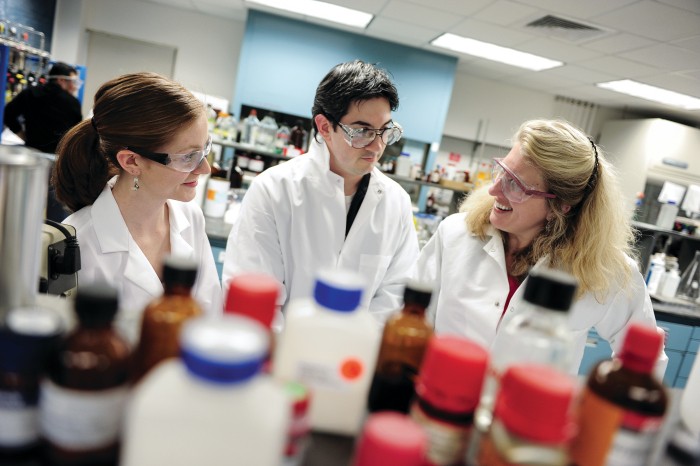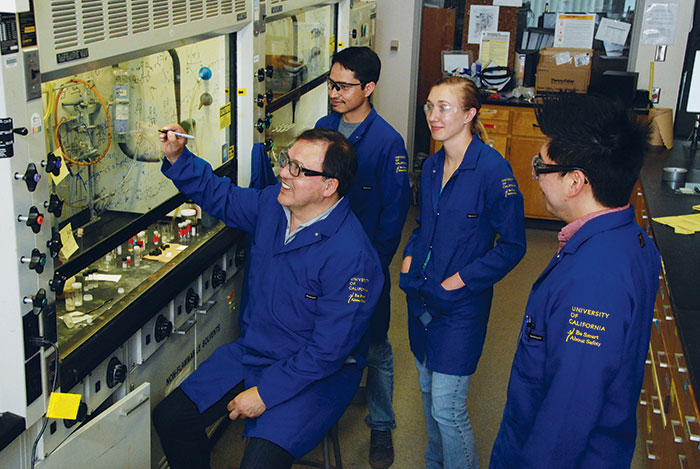Advertisement
Grab your lab coat. Let's get started
Welcome!
Welcome!
Create an account below to get 6 C&EN articles per month, receive newsletters and more - all free.
It seems this is your first time logging in online. Please enter the following information to continue.
As an ACS member you automatically get access to this site. All we need is few more details to create your reading experience.
Not you? Sign in with a different account.
Not you? Sign in with a different account.
ERROR 1
ERROR 1
ERROR 2
ERROR 2
ERROR 2
ERROR 2
ERROR 2
Password and Confirm password must match.
If you have an ACS member number, please enter it here so we can link this account to your membership. (optional)
ERROR 2
ACS values your privacy. By submitting your information, you are gaining access to C&EN and subscribing to our weekly newsletter. We use the information you provide to make your reading experience better, and we will never sell your data to third party members.
Women In Science
Women crack the academic glass ceiling
Gender survey shows solid gains in overall percentage of female faculty at top chemistry departments
by Linda Wang
September 12, 2016
| A version of this story appeared in
Volume 94, Issue 36

Interactive: Find more data and compare current stats with those that go back to 2011–12, visit http://cenm.ag/oxide1213.
Efforts to increase the representation of women among chemistry faculty at top Ph.D.-granting institutions appear to be paying off. The percentage of women holding faculty positions at the top 50 schools in terms of chemical R&D spending was 19.1% for the 2014–15 academic year, a more than 2% gain over the previous academic year, according to the latest survey conducted by the Open Chemistry Collaborative in Diversity Equity (OXIDE), a diversity equity initiative cofunded by the National Science Foundation, the National Institutes of Health, and the Department of Energy.
“We have been looking at such small incremental pushes in the past, and to see an almost 2% jump in the last year shows that there is something happening within this field,” says Dontarie M. Stallings, OXIDE’s research and program manager. “There is recognition of what females bring to our chemistry field and to our community.”

Note: Tenured and tenure-track women chemistry faculty at the 50 schools identified by the National Science Foundation as having spent the most on chemistry research in fiscal 2014. The top departments in terms of the percentage of women is based on the 75 schools that spent the most on chemistry research in 2014.
Source: OXIDE survey
The data show that the largest gains for women were made at the associate professor level, which jumped from 25.5% in 2013–14 to 29.7% in 2014–15. The percentages of female assistant professors and full professors at the top 50 departments grew slightly from 25.1% in 2013–14 to 26.1% in 2014–15, and from 13.3% in 2013–14 to 14.4% in 2014–15.
Despite these gains, the percentage of women faculty still lags behind the number of women earning doctorates. According to NSF’s Survey of Earned Doctorates, the percentage of women earning doctorates in chemistry in 2014 was 38.2%. “The bottom line is that we want all of the talent we can get to be engaged in research, education, and training,” says Angela Wilson, director of NSF’s division of chemistry and a chemistry professor at Michigan State University. “Ensuring that women chemists are among a university’s faculty provides inherent role models, which help to encourage a broader talent base. Diversity provides perspectives that make science stronger.”
Find more data and compare the 2014–15 stats with those that go back to 2011–12 at cenm.ag/oxide1213.
OXIDE aims to broaden faculty diversity in gender, race and ethnicity, disabilities, and sexual orientation. Every two years, OXIDE organizes a National Diversity Equity Workshop, where chairs of chemistry departments around the U.S. come together to discuss strategies to reduce barriers to diversity equity, such as implicit bias, and increase the representation of women and underrepresented minority faculty.
Led by Rigoberto Hernandez, a chemistry professor at Johns Hopkins University, OXIDE is among the more recent efforts to track data on women and underrepresented minority faculty in the chemical sciences. It began collecting annual data on women in 2009 and on underrepresented minorities in 2011 (C&EN, May 18, 2015, page 37). C&EN alternates in the years it reports the gender and underrepresented minority survey data.
Other efforts to compile data on women and underrepresented minority faculty were made by the ACS Women Chemists Committee in the 1970s and 80s, and later by the Nelson Diversity Surveys, conducted by Donna Nelson at the University of Oklahoma (C&EN, Jan. 4, page 2).
In addition to OXIDE, other initiatives aimed at addressing the gender gap include the NSF ADVANCE grants to increase the participation and advancement of women in academic science and engineering careers, and COACh, a grassroots organization offering career building workshops and other programs to help women succeed.
Christy Haynes, a chemistry professor at the University of Minnesota, says she has noticed in recent years more awareness among faculty about the potential for implicit bias, which is bias that can manifest itself subconsciously. “Five years ago, I don’t think that was really the case,” she says. “I feel like we’ve moved beyond just the simple information stage, and are now trying to do some real solutions-based work.”
In her own chemistry department, she has found a simple approach to encourage more hiring of women. “I haven’t been shy about going straight to my chair and saying I met this great person at a conference, I think we should try and move her here,” she says. “I’ve gotten traction on that more than once in this department. That’s certainly one way to move your numbers.”
Nevertheless, the numbers of women faculty remain small, particularly at the full professor level. “If you just look at the numbers, we have a long way to go. If you look at individual success stories, I think there are a lot of people that are very successful that are women and underrepresented minorities,” says Kay Brummond, chair and professor of chemistry at the University of Pittsburgh.
Two years ago, Brummond became the first female chair in the history of the department. She says part of the challenge involves changing the culture. “There have been times when our seminar slate has been almost entirely male,” Brummond says. “If you have no women on your seminar slate, it’s sending a message to students that only men have science worthy of presenting.” She says her department is working on making sure women have more representation on the seminar slates.
Brummond’s own journey to becoming a chemistry professor started with a female chemistry professor she had as an undergraduate student. “It was the first time I had a faculty member that was a female in chemistry,” she says. “It dawned on me that I could do that, and that I wanted to do that. Prior to seeing her, I had never imagined myself as a professor of chemistry.”
The earlier that a female student receives the support she needs during her training, the more likely she is to consider a career in academia, Brummond says. “One of the key interventions that I think can be helpful is making sure that students complete their degrees on time,” she explains. “That’s one of the things that can impact women’s decisions to go into a postdoc. If they’re spending six or seven years getting their Ph.D., then doing a postdoc that can last anywhere from one to three years, a decision to go into academia can be difficult because of the ticking biological clock.”
Nicole Sampson, chair of the chemistry department at Stony Brook University, theorizes that tight funding and increasing awareness about alternative careers is contributing to new graduates choosing careers outside of academia. “There has been a massive attempt to change the mindset that a Ph.D. is preparation for an academic job,” she says. “Since I’ve been chair, we’ve run several faculty searches, and I’ve been disappointed at the fraction of the pool that are women, and these are pools of 200 to 400 candidates.”
On the other hand, more women are in faculty positions than ever before, Sampson says. “We’re just at the cusp of where women like myself who were hired 25 years ago now are becoming chairs of chemistry departments,” she notes. “The role models we present to our students now are much more diverse than they were 25 years ago.”
To encourage retention of women and avoid the two-body career problem, Sampson says her department helps spouses of faculty find jobs at the university. “The consequence of that is we actually have several married couples in the department. That, I think, has set the stage for the department being a welcoming place.”

In addition, each faculty member has three mentors to help them with various aspects of their career. “We’ve made a huge investment in our faculty, and we want them to succeed,” Sampson says.
At the University of Oklahoma, chemistry department chair Ron Halterman says that they’ve added graduate student representation to their search committees. “Students are looking more at the mentoring relationship and they may not be quite so concerned with the metrics, like numbers of papers. They’re more interested in whether this person can communicate clearly,” he says.
He cautions against overburdening women with service. “Until two or three years ago, we didn’t have very many women, and we kept calling on them to do a lot of extra committee work,” he says. “You have to pick your investments of time.”
Recruiting more women and retaining them is only half the battle, says Andrew Feig, a professor of chemistry at Wayne State University. “We need to see them progressing into leadership roles, and we need to see that women faculty are winning national awards, that they’re getting nominated at the appropriate rate, and that they’re successful in all aspects of their career, not just landing the job.”
Haynes says that real change happens when the entire community invests in achieving diversity equity. “It’s really easy to say, come on women, work harder to make more changes. You need to have everyone on board. You really need to have the white men in the room to also be interested in diversifying, or else it doesn’t happen,” she says. “That’s something OXIDE is working really hard to inspire. In bringing all the chairs together, they’re trying to make sure that all the work to increase diversity doesn’t land on the people that are the diversity.”
The gains that women make will be felt by all underrepresented groups. “People think that if you change the climate and make it better for women, that it only affects women. No,” Stallings says. “Data has shown that if you change the climate and make it better for women, it makes it better for every single demographic within that department.”

Note: Tenured and tenure-track faculty at the 50 schools identified by the National Science Foundation as having spent the most on chemistry research in fiscal 2014. For schools whose NSF ranking is based on multiple campuses, faculty numbers are for campuses listed in parentheses. na = not available. a Did not reply to requests for information. b Declined to participate.
Source: OXIDE survey
On Sept. 20, 2016, this story was corrected to reflect the actual number of female faculty at Texas A&M University. This correction changes the overall percentage of full female professors at the top 50 departments to 14.4% in 2014–15, which is an increase in representation of 1%, not 2%, from the previous year. In the infographic, the top departments in terms of the percentage of women is based on the 75 schools identified by the National Science Foundation that spent the most on chemistry research in 2014.





Join the conversation
Contact the reporter
Submit a Letter to the Editor for publication
Engage with us on Twitter